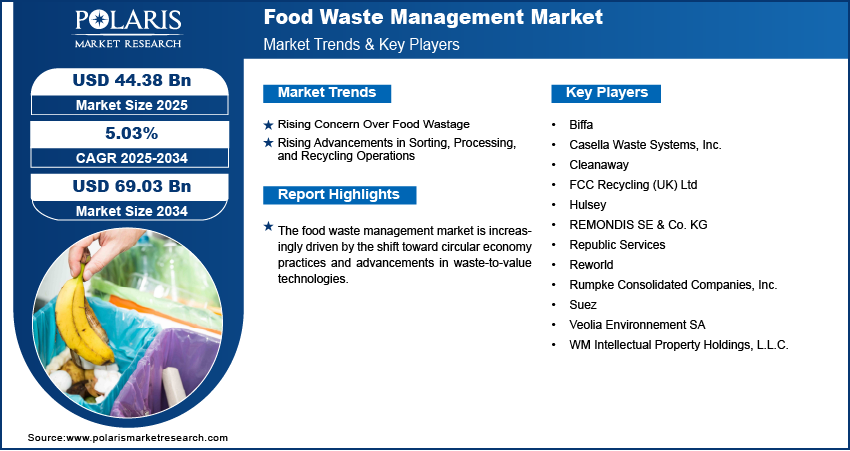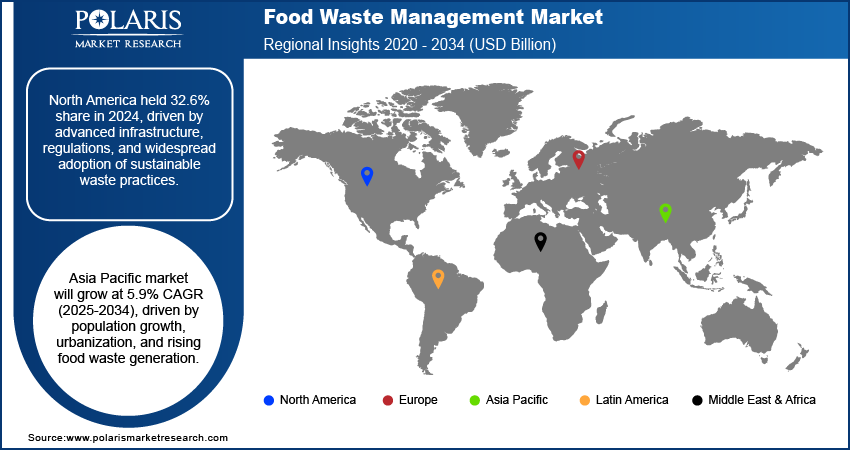
Food Waste Management Market Size, Share, & Industry Analysis Report
By Waste Type (Cereals, Dairy Products, Fruits & Vegetables), By Process, By Source, By Application, and By Region – Market Forecast, 2025–2034
- Published Date:Jan-2022
- Pages: 105
- Format: PDF
- Report ID: PM1862
- Base Year: 2021
- Historical Data: 2017 - 2020
Report Outlook
Overview
The global food waste management market size was valued at USD 42.30 billion in 2024, growing at a CAGR of 5.03% from 2025–2034. Key factors driving demand include rising production of animal feed and organic fertilizers from waste valorization, rising government encouragement, rising concern over food wastage, advancements in sorting, processing, and recycling operations.
Key Insights
- The fruits and vegetables segment led the market with a 39.83% revenue share in 2024, primarily due to their highly perishable nature and short shelf life.
- The anaerobic digestion segment is projected to be the fastest-growing process, with a 5.6% CAGR, as it generates renewable biogas while managing organic waste.
- North America held a dominant 32.6% global market share in 2024, supported by advanced infrastructure, strong regulations, and high adoption of sustainable practices.
- The U.S. dominated the North American region in 2024, driven by its strict policies, refined infrastructure, and widespread use of advanced treatment technologies.
- The Asia Pacific market is expected to grow at a 5.9% CAGR from 2025 to 2034, fueled by rapid urbanization, growing populations, and rising food waste volumes.
- India's market is expanding due to increasing food waste from urbanization, population growth, and changing consumer consumption patterns.
Industry Dynamics
- Growing concern over food waste is creating expansion opportunities by highlighting the need to mitigate its environmental, social, and economic consequences.
- Technological progress in AI and automated sorting is boosting market growth by enhancing the efficiency and quality of food waste recycling.
- High initial investment and operational costs for advanced processing technologies like anaerobic digestion plants remain a major barrier to widespread adoption.
- Growing demand for renewable energy and organic fertilizers creates revenue opportunities by converting waste into valuable biogas and nutrient-rich products.
Market Statistics
- 2024 Market Size: USD 42.30 billion
- 2034 Projected Market Size: USD 69.03 billion
- CAGR (2025-2034): 5.03%
- North America: Largest market in 2024
Food waste management is the systematic collection, treatment, and utilization of discarded food materials to minimize environmental impact and extract value from waste streams. The market is driven by the rising production of animal feed and organic fertilizers through waste generation. According to an ICAR 2022 report, India generates approximately 500 million tonnes of crop residue each year. Although a notable portion is repurposed, a surplus of 140 million tonnes remains, with 92 million tonnes being burned annually. Industries are addressing both sustainability concerns and resource efficiency by converting food waste into nutrient-rich feed and compost. This practice reduces dependence on synthetic fertilizers and conventional feed sources while simultaneously lowering the volume of waste that ends up in landfills. Additionally, the growing recognition of food waste as a valuable input rather than a liability has encouraged businesses to adopt circular economy practices, strengthening the role of waste-to-value processes in the overall growth.

The rising government encouragement aimed at improving food waste management practices further contributes to the growth opportunities. Regulatory bodies across regions are implementing frameworks, guidelines, and incentives to promote waste segregation, recycling, and resource recovery. Policies are increasingly designed to support sustainable waste treatment technologies, reduce greenhouse gas emissions, and promote eco-friendly disposal methods. In addition, public–private collaborations and awareness campaigns are creating favorable conditions for the adoption of efficient food waste management systems. This supportive regulatory environment ensures compliance and also motivates industries to innovate and invest in advanced treatment solutions, thereby driving long-term growth in the sector.
Drivers & Opportunities
Rising Concern Over Food Wastage: Rising concern over food wastage is driving the expansion opportunities, as it highlights the urgent need to reduce the social, environmental, and economic impacts of discarded food. A September 2024 UN report stated that 13.2% of global food production is lost between harvest and retail, with an additional 19% wasted at the consumer and retail levels. Stakeholders across industries are under increasing pressure to adopt sustainable disposal practices with a growing awareness of how food wastage contributes to resource depletion, landfill accumulation, and greenhouse gas emissions. This concern has also shifted consumer viewpoint, encouraging businesses to establish responsibility by implementing effective waste reduction and management strategies. As a result, demand for advanced food waste management solutions is strengthening, as they help minimize losses, optimize resource utilization, and support global sustainability goals.
Rising Advancements in Sorting, Processing, and Recycling Operations: Advancements in sorting, processing, and recycling operations are another factor driving the growth of the market, as technological progress enhances efficiency and recovery rates. Modern sorting systems, equipped with automation, AI, and sensor-based technologies, enable precise segregation of edible and non-edible fractions, improving the quality of recovered materials. For instance, in April 2025, Lufthansa Group launched an AI tool to scan returned airline meals. It analyzes consumption patterns to optimize future catering, aiming to reduce food waste, lower onboard weight, and cut carbon dioxide emissions. Innovations in processing and recycling further allow food waste to be converted into bioenergy, animal feed, and compost with higher yields and reduced costs. These advancements make waste management more commercially viable while aligning with circular economy practices. Therefore, by streamlining operations and improving scalability, technological improvements are making waste management both a sustainable and profitable approach, thereby accelerating its adoption across industries.

Segmental Insights
Waste Type Analysis
Based on waste type, the segmentation includes cereals, dairy products, fruits & vegetables, meat, fish, & seafood, processed food, and other waste types. The fruits & vegetables segment accounted for 39.83% revenue share in 2024 due to the high perishability and short shelf life of these products. Large-scale losses occur during harvesting, transportation, storage, and retail stages, making fruits and vegetables the most important contributors to global food waste volumes. Moreover, their nutrient-rich composition also makes them suitable for conversion into compost, biofertilizers, and bioenergy, thereby encouraging efficient waste valorization. This combination of high waste generation and strong potential for recycling has established the dominance of this segment within the food waste management market.
Process Analysis
In terms of process, the segmentation includes anaerobic, aerobic, combustion/incineration, other processes. The anaerobic segment is expected to witness fastest growth at a CAGR of 5.6% during the forecast period due to its ability to simultaneously manage waste and produce renewable energy in the form of biogas. This process is highly favored for its environmental benefits, such as reduced methane emissions from landfills and minimized reliance on conventional fossil fuels. Additionally, anaerobic digestion yields nutrient-rich digestate, which is used as an organic fertilizer, further supporting circular economy initiatives. Its dual advantage of waste reduction and energy recovery makes anaerobic processes an increasingly preferred choice for sustainable food waste management.
Source Analysis
The segmentation, based on source, includes primary food producers, food manufacturers, food distributors & suppliers, food service providers, and municipalities & households. The municipalities & households segment held 37.47% revenue share in 2024 driven by the volume of food waste generated at the consumer level. Inefficient consumption patterns, improper storage practices, and a lack of awareness about food portioning contribute to waste accumulation in this segment. Additionally, municipal authorities are increasingly implementing structured collection and disposal systems, encouraging recycling and composting at both community and household levels. This high generation rate, combined with growing efforts to manage waste sustainably, positions municipalities and households as the leading contributors to the market.
Application Analysis
Based on application, the segmentation includes, animal feed, fertilizers, biofuel, and power generation. The fertilizers segment is expected to witness robust growth at a CAGR of 5.6% during the forecast period attributed to the rising demand for organic farming practices and sustainable soil enrichment solutions. Food waste provides a nutrient-dense base for producing compost and bio fertilizers, offering an eco-friendly alternative to synthetic chemical fertilizers. This helps improve soil health and agricultural productivity, while also reducing the environmental footprint associated with conventional farming inputs. Furthermore, the increasing global focus on sustainable agriculture and resource recovery strongly supports the expansion of food waste-derived fertilizers, boosting growth in this application segment.

Regional Analysis
North America food waste management market accounted for 32.6% of global market share in 2024. This dominance is due to the presence of advanced waste treatment infrastructure, strong regulatory frameworks, and the widespread adoption of sustainable practices by industries and municipalities. High levels of consumer awareness, driven by initiatives from both government and private organizations, have further strengthened the region's position in addressing food waste challenges. Additionally, investments in technologies such as anaerobic digestion, composting, and recycling have improved the efficiency of waste valorization processes. For example, in March 2025, EnviTec Biogas commissioned its largest anaerobic digestion plant in South Dakota, which processes manure from over 9,500 dairy cows daily to produce renewable natural gas, helping to meet regional renewable energy goals. These factors collectively contribute to North America's leadership in shaping the global food waste management landscape.
U.S. Food Waste Management Market Insight
U.S. held dominating market share in North America food waste management landscape in 2024 due to its well-established infrastructure, strict environmental regulations, and large-scale adoption of advanced waste treatment technologies. Strong governmental initiatives supporting landfill diversion, with private sector investments in anaerobic digestion and composting, have reinforced its leading position. Additionally, consumer awareness campaigns and corporate sustainability commitments have further driven the development of structured waste management solutions across the country.
Asia Pacific Food Waste Management Market
The market in Asia Pacific is projected to grow at a CAGR of 5.9% from 2025-2034, owing to rising population levels, rapid urbanization, and the increasing volume of food waste generated across both rural and urban areas. Growing concerns about food security and environmental sustainability are encouraging governments and industries to adopt structured waste management practices. The region is witnessing greater focus on converting waste into value-added products such as fertilizers, animal feed, and bioenergy to support its expanding agricultural and energy needs. Moreover, improvements in waste processing technologies and increased regulatory focus are anticipated to drive the adoption of food waste management solutions throughout the Asia Pacific region.
India Food Waste Management Market Overview
The market in India is expanding due to the increasing levels of food waste generated from urbanization, population growth, and evolving consumption patterns. Rising government focus on sustainable waste handling and the promotion of decentralized composting and biogas projects are driving adoption. Moreover, the push for organic fertilizers to support agriculture, along with initiatives to reduce landfill dependency, is creating strong opportunities for food waste valorization. Growing participation of private players and startups in this space is also supporting the market’s growth.
Europe Food Waste Management Market
The food waste management landscape in Europe is projected to hold a substantial share in 2034 due to the region’s commitment to sustainability goals and strict regulatory orders on waste reduction. Europe has been at the forefront of implementing circular economy principles, encouraging recycling, composting, and the recovery of valuable resources from waste streams. The growing shift toward organic farming and renewable energy further supports the valorization of food waste into fertilizers and bioenergy. Moreover, strong collaboration between policymakers, industries, and households ensures higher compliance with waste segregation and recycling initiatives. This proactive approach positions Europe as a major region contributing to global advancements in food waste management practices.
Germany Food Waste Management Market
Germany market is driven by the country's strong commitment to sustainability, strict waste segregation policies, and a robust recycling infrastructure. Germany has long been a leader in implementing circular economy principles, with a well-established system for converting food waste into biogas and organic fertilizers. The integration of advanced sorting and processing technologies ensures the efficient recovery of resources. Additionally, strong collaboration among municipalities, industries, and consumers supports a highly efficient and environmentally responsible food waste management ecosystem in the country.

Key Players & Competitive Analysis Report
The food waste management competitive landscape is shaped by technological advancement and strategic focus on sustainable value chains. Players are leveraging competitive intelligence and strategy to capitalize on expansion opportunities, particularly within emerging markets where rapid urbanization and economic and geopolitical shifts are driving latent demand and opportunities. Vendor strategies increasingly involve strategic investments in anaerobic digestion and AI-driven sorting to enhance revenue growth. While developed markets are saturated with established vendor share, high growth projections in Asia-Pacific are attracting new entrants. Success hinges on navigating supply chain disruptions and aligning with regional macroeconomic trends to build resilient industry ecosystems. Expert's insight confirms that innovation in conversion technologies represents the foremost revenue opportunity.
Major companies operating in the food waste management industry include Biffa; Casella Waste Systems, Inc.; Cleanaway; FCC Recycling (UK) Ltd; Hulsey; REMONDIS SE & Co. KG; Republic Services; Reworld; Rumpke Consolidated Companies, Inc.; Suez; Veolia Environnement SA; and WM Intellectual Property Holdings, L.L.C.
Key Players
- Biffa
- Casella Waste Systems, Inc.
- Cleanaway
- FCC Recycling (UK) Ltd
- Hulsey
- REMONDIS SE & Co. KG
- Republic Services
- Reworld
- Rumpke Consolidated Companies, Inc.
- Suez
- Veolia Environnement SA
- WM Intellectual Property Holdings, L.L.C.
Industry Developments
- July 2025: Divert, Inc. partnered with United States Cold Storage to launch a recycling program. It will convert unsold food and beverage products into renewable energy and soil amendments, supporting circular economy principles.
- May 2025: Bristol Superlight, FareShare, FuturePlus, Google Cloud, Howard Tenens Logistics, Nestlé UK&I and Zest launched an AI-led food redistribution initiative. The project aims to redirect surplus edible food to reduce waste, lower CO₂ emissions, and achieve cost savings through optimized logistics.
Food Waste Management Market Segmentation
By Waste Type Outlook (Revenue, USD Billion, 2020–2034)
- Cereals
- Dairy products
- Fruits & Vegetables
- Meat, Fish, & Seafood
- Processed Food
- Other Waste Types
By Process Outlook (Revenue, USD Billion, 2020–2034)
- Anaerobic
- Aerobic
- Combustion/Incineration
- Other Processes
By Source Outlook (Revenue, USD Billion, 2020–2034)
- Primary Food Producers
- Food Manufacturers
- Food Distributors & Suppliers
- Food Service Providers
- Municipalities & Households
By Application Outlook (Revenue, USD Billion, 2020–2034)
- Animal Feed
- Fertilizers
- Biofuel
- Power Generation
By Regional Outlook (Revenue, USD Billion, 2020–2034)
- North America
- US
- Canada
- Europe
- Germany
- France
- UK
- Italy
- Spain
- Netherlands
- Russia
- Rest of Europe
- Asia Pacific
- China
- Japan
- India
- Malaysia
- South Korea
- Indonesia
- Australia
- Vietnam
- Rest of Asia Pacific
- Middle East & Africa
- Saudi Arabia
- UAE
- Israel
- South Africa
- Rest of Middle East & Africa
- Latin America
- Mexico
- Brazil
- Argentina
- Rest of Latin America
Food Waste Management Market Report Scope
|
Report Attributes |
Details |
|
Market Size in 2024 |
USD 42.30 Billion |
|
Market Size in 2025 |
USD 44.38 Billion |
|
Revenue Forecast by 2034 |
USD 69.03 Billion |
|
CAGR |
5.03% from 2025 to 2034 |
|
Base Year |
2024 |
|
Historical Data |
2020–2023 |
|
Forecast Period |
2025–2034 |
|
Quantitative Units |
Revenue in USD Billion and CAGR from 2025 to 2034 |
|
Report Coverage |
Revenue Forecast, Competitive Landscape, Growth Factors, and Industry Trends |
|
Segments Covered |
|
|
Regional Scope |
|
|
Competitive Landscape |
|
|
Report Format |
|
|
Customization |
Report customization as per your requirements with respect to countries, regions, and segmentation. |
FAQ's
The global market size was valued at USD 42.30 billion in 2024 and is projected to grow to USD 69.03 billion by 2034.
The global market is projected to register a CAGR of 5.03% during the forecast period.
North America food waste management market accounted for 32.6% of global market share in 2024.
A few of the key players in the market are Biffa; Casella Waste Systems, Inc.; Cleanaway; FCC Recycling (UK) Ltd; Hulsey; REMONDIS SE & Co. KG; Republic Services; Reworld; Rumpke Consolidated Companies, Inc.; Suez; Veolia Environnement SA; and WM Intellectual Property Holdings, L.L.C.
The fruits & vegetables segment accounted for 39.83% revenue share in 2024.
The anaerobic segment is expected to witness fastest growth at a CAGR of 5.6% during the forecast period.
